The woofer plans with the BR port on the bottom
The Tweeter and Mid Closed box, not filled, just foam around the walls
An externally hosted image should be here but it was not working when we last tested it.
The Tweeter and Mid Closed box, not filled, just foam around the walls
An externally hosted image should be here but it was not working when we last tested it.
Some measurements from the designer
An externally hosted image should be here but it was not working when we last tested it.
An externally hosted image should be here but it was not working when we last tested it.
An externally hosted image should be here but it was not working when we last tested it.
Hi Jogas
I have simulated the TFS1 in Leap. Afterwards more details about the simulation results. Here is the SPL of the filtered drivers in their cabinet.
This is the free field response at 1m and 2.83Vrms.
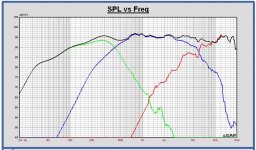
You can see that this system has a SPL fall off below 200Hz and is about 12dB down at 50Hz. Maybe this explains your listening experiences, some missing of low frequency power.
It can be explained very simple. The Beyma woofer has an efficiency of about 93.5 dB on infinite baffle at 1m and 2.83Vrms for low frequencies around 100Hz. Due to the bafflestep of the enclosure you loose 6dB for low frequencies in free field. This means that, to design a system which is flat up to low frequencies in free field, the overall efficiency of your system can only be about 87dB at 1m and 2.83Vrms. Now it is 95dB and so you have too much low frequency fall off.
It is up to you now to decide how you will progress.
You can do some active equalization of the SPL.
Or the crossover filter can be redesigned for a more flat response up to low frequencies. I can do that if you want.
Do you have the equipment to measure some responses? Impedance, SPL?
If yes you maybe can do some control measurements. If no I have to take the responses of my actual simulation. The simulation is based now on the supplier specification of the drivers. There can be some deviation of your drivers w.r.t. that specification. But we can try it out.
Are you playing with a tube amplifier? I see one on the picture of your room that you posted . In that case we have to take into account the output impedance of that amplifier in the case it is not low impedant out.
. In that case we have to take into account the output impedance of that amplifier in the case it is not low impedant out.
I have simulated the TFS1 in Leap. Afterwards more details about the simulation results. Here is the SPL of the filtered drivers in their cabinet.
This is the free field response at 1m and 2.83Vrms.

You can see that this system has a SPL fall off below 200Hz and is about 12dB down at 50Hz. Maybe this explains your listening experiences, some missing of low frequency power.
It can be explained very simple. The Beyma woofer has an efficiency of about 93.5 dB on infinite baffle at 1m and 2.83Vrms for low frequencies around 100Hz. Due to the bafflestep of the enclosure you loose 6dB for low frequencies in free field. This means that, to design a system which is flat up to low frequencies in free field, the overall efficiency of your system can only be about 87dB at 1m and 2.83Vrms. Now it is 95dB and so you have too much low frequency fall off.
It is up to you now to decide how you will progress.
You can do some active equalization of the SPL.
Or the crossover filter can be redesigned for a more flat response up to low frequencies. I can do that if you want.
Do you have the equipment to measure some responses? Impedance, SPL?
If yes you maybe can do some control measurements. If no I have to take the responses of my actual simulation. The simulation is based now on the supplier specification of the drivers. There can be some deviation of your drivers w.r.t. that specification. But we can try it out.
Are you playing with a tube amplifier? I see one on the picture of your room that you posted
For a three way design, the TFS1 requires a musical woofer capable of:
*400Hz crossover
*F3 around 35Hz
*sensitivity around 97-98db to provide baffle step compensation which can support the 95db midrange.
There are a couple 18" woofers, and a few 15" woofers that are favored for this task in the diy community. At the 400Hz crossover frequency, in order to maintain a 9"-10" quarter wavelength C-to-C, the woofer should be mounted about 20" off the floor. This height also modestly reduces the quarter wave (96" ceiling) ground bounce. 6cuft ported cabinet modeled
Lowest Cost: Peavey LoRider18 560600 $220.
Popular: Faital 18FH500
Cult Favorite: Beyma 18P80Nd (18P80Fe), Acoustic Elegance TD18H+
Popular: Faital 15FH520
Cult Favorite: Acoustic Elegance TD15S, Altec(GPA) 416B
============
If you desire MONSTER BASS, you could put a 12" midbass with 97-98db sensitivity in a modest volume sealed box just below your midrange which can cover 400Hz down to ~60Hz, and add a MONSTER 15" or 18" subwoofer with a separate amp + room compensation filters. At 60Hz you can locate the subwoofers around the room for reduced bass modes. Now the 1812 Overture -can- knock down your walls.
*400Hz crossover
*F3 around 35Hz
*sensitivity around 97-98db to provide baffle step compensation which can support the 95db midrange.
There are a couple 18" woofers, and a few 15" woofers that are favored for this task in the diy community. At the 400Hz crossover frequency, in order to maintain a 9"-10" quarter wavelength C-to-C, the woofer should be mounted about 20" off the floor. This height also modestly reduces the quarter wave (96" ceiling) ground bounce. 6cuft ported cabinet modeled
Lowest Cost: Peavey LoRider18 560600 $220.
Popular: Faital 18FH500
Cult Favorite: Beyma 18P80Nd (18P80Fe), Acoustic Elegance TD18H+
Popular: Faital 15FH520
Cult Favorite: Acoustic Elegance TD15S, Altec(GPA) 416B
============
If you desire MONSTER BASS, you could put a 12" midbass with 97-98db sensitivity in a modest volume sealed box just below your midrange which can cover 400Hz down to ~60Hz, and add a MONSTER 15" or 18" subwoofer with a separate amp + room compensation filters. At 60Hz you can locate the subwoofers around the room for reduced bass modes. Now the 1812 Overture -can- knock down your walls.
Free field ? I see a pavement ( + 3 dB )Due to the bafflestep of the enclosure you loose 6dB for low frequencies in free field. This means that, to design a system which is flat up to low frequencies in free field, the overall efficiency of your system can only be about 87dB at 1m and 2.83Vrms. Now it is 95dB and so you have too much low frequency fall off.
95 dB ? I see some passive components to limit its band

Free field ? I see a pavement ( + 3 dB )
95 dB ? I see some passive components to limit its band

With the actual crossover filter the free field SPL is about 95dB for the mid and high frequencies and 84dB at 50Hz (1m and 2.83Vrms).
To realize a F3 at about 50Hz the SPL should be designed to be 87dB for the mid and high frequencies. In that way you make a system that is flat down to much lower frequencies.
For a higher SPL you have to choose a more powerful woofer(s).
Attached sim comparing 15" Faital 15FH520 with 12" Beyma 12B100/R in a ported 6cuft volume cabinet. In this sim, the 15FH520 generates a 95db sensitivity at 400Hz similar to the midrange sims. Larger Box. Larger woofer. Just add a little room gain.
Attached sim of 12B100 in 6cuft ported bass shelf alignment to illustrated potential bass extension if speaker is placed up against the walls. Even in a 6cuft box, the 12B100 still has 3db lower SPL at the 400Hz Xover than the midrange or the 15FH520 example.
You could build a larger (6cuft) ported cabinet and experiment with your 12B100 before you purchase a 15" or 18" higher efficiency woofer for that box. Just route a larger hole and change port length.
I'm sure you will get other suggestions for suitable 15" high efficiency woofers. Higher price 18Sound and BMS models can be sim'ed and compared.
Attached sim of 12B100 in 6cuft ported bass shelf alignment to illustrated potential bass extension if speaker is placed up against the walls. Even in a 6cuft box, the 12B100 still has 3db lower SPL at the 400Hz Xover than the midrange or the 15FH520 example.
You could build a larger (6cuft) ported cabinet and experiment with your 12B100 before you purchase a 15" or 18" higher efficiency woofer for that box. Just route a larger hole and change port length.
I'm sure you will get other suggestions for suitable 15" high efficiency woofers. Higher price 18Sound and BMS models can be sim'ed and compared.
Attachments
@ LineSource
Your simulation SPL values are values on infinite baffle. Placing the box in free field, 6dB will be lost for low frequencies, below about 200Hz for the TFS1 enclosure.
For my designs I prefer a flat SPL design in free field down to low frequencies. For the Beyma 12B100 in 70 litres and tuned at 38Hz (TFS1 values), a F3=38Hz can be realized. In this way it is about a ported B4 alignment. To realize an overall flat SPL in free field, you have to limit the midrange SPL to about 87dB.
Dependent on the room acoustics and the position of the speaker in the room, some low frequency equalization can be performed if needed.
Larger volume and lower tuning frequency will lower the F3. It will become more a QB3 alignment, but the system Q values will become higher too. I prefer the B4 alignments for basreflex systems.
Your simulation SPL values are values on infinite baffle. Placing the box in free field, 6dB will be lost for low frequencies, below about 200Hz for the TFS1 enclosure.
For my designs I prefer a flat SPL design in free field down to low frequencies. For the Beyma 12B100 in 70 litres and tuned at 38Hz (TFS1 values), a F3=38Hz can be realized. In this way it is about a ported B4 alignment. To realize an overall flat SPL in free field, you have to limit the midrange SPL to about 87dB.
Dependent on the room acoustics and the position of the speaker in the room, some low frequency equalization can be performed if needed.
Larger volume and lower tuning frequency will lower the F3. It will become more a QB3 alignment, but the system Q values will become higher too. I prefer the B4 alignments for basreflex systems.
If you have no experience with crossover design - For sure go with a proven kit.
How about zaph audio sb12.3 ? I have not heard it though.
You cannot change the dimensions of the frontbaffle without building a whole new crossover (As with any other KITs)
This is good advice.
Sent from my Nexus 6 using Tapatalk
Jogas,
Just to show you what could be possible by designing another X-over filter for your actual TFS1 system.
I have designed a LR4 filter with X-over fequencies at 400 and 3000Hz.
It is just an example.
The new X-over schematic
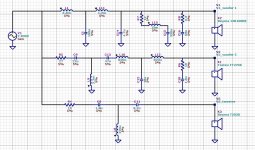
The SPL response at 1m and 2.83Vrms in free field
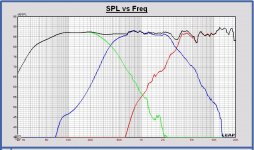
The SPL response and the LR4 targets added in grey color
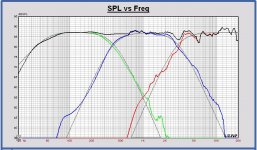
You see that the SPL is flat now down to low frequences, -3dB point at 50Hz.
But the overall SPL at 1m, 2.83Vrms is decreased to 87dB.
This TFS1 system doesn't have the good combination of drivers to make a flat SPL system. The midrange and tweeter have to be attenuated too much.
To get more SPL out of your system with more low frequency power, you have to choose a woofer system with more SPL like other collegues are mentioning too.
Suppose you like to modify your current crossover and keep your driver set, I can design also more simple X-overs like a LR2 or a B3. Making some modifications in your actual filter to make the SPL more flat is also an option.
Just to show you what could be possible by designing another X-over filter for your actual TFS1 system.
I have designed a LR4 filter with X-over fequencies at 400 and 3000Hz.
It is just an example.
The new X-over schematic

The SPL response at 1m and 2.83Vrms in free field

The SPL response and the LR4 targets added in grey color

You see that the SPL is flat now down to low frequences, -3dB point at 50Hz.
But the overall SPL at 1m, 2.83Vrms is decreased to 87dB.
This TFS1 system doesn't have the good combination of drivers to make a flat SPL system. The midrange and tweeter have to be attenuated too much.
To get more SPL out of your system with more low frequency power, you have to choose a woofer system with more SPL like other collegues are mentioning too.
Suppose you like to modify your current crossover and keep your driver set, I can design also more simple X-overs like a LR2 or a B3. Making some modifications in your actual filter to make the SPL more flat is also an option.
and what about enclosing your bass? I am currently doing some test and research and i am getting fair results with a "box in the box" concept - I am now trying to do a base of isobaric for the bass but the amount of work is so big i need to take some holidays only to run tests 
Jogas
I have made a simple redesign of your current X-over to make the SPL more flat.
You have to modify only 4 components.
Schematic
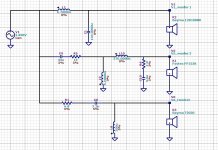
In the woofer filter:
Change the coil of 5.5mH/0.5E to 6.7m/0.8E by placing a coil of 1.2mH/0.3E in series.
Change capacitor of 100uF to 133uF by placing 33uF parallel.
In the midrange filter:
Change resistor of 4.7E to 15E
In the tweeter filter:
Change resistor of 2.2E to 6.8E
SPL with modified filter
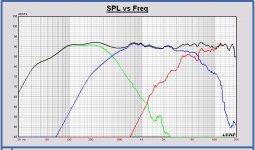
It is a simple test that can be done to get an impression of a more flat SPL.
I take some risk by using all specification parameters for the drivers.
Maybe the ones you have are different, but let us hope it is not that big difference.
I have made a simple redesign of your current X-over to make the SPL more flat.
You have to modify only 4 components.
Schematic

In the woofer filter:
Change the coil of 5.5mH/0.5E to 6.7m/0.8E by placing a coil of 1.2mH/0.3E in series.
Change capacitor of 100uF to 133uF by placing 33uF parallel.
In the midrange filter:
Change resistor of 4.7E to 15E
In the tweeter filter:
Change resistor of 2.2E to 6.8E
SPL with modified filter

It is a simple test that can be done to get an impression of a more flat SPL.
I take some risk by using all specification parameters for the drivers.
Maybe the ones you have are different, but let us hope it is not that big difference.
In the specifcation of the Fostex FF225K-8 the Xmax is specified 0.3mm (0.012inch). Anyone who does understand this low value?
3mm should be more acceptable for an 8 inch?
View attachment Fostex FF225K-8.pdf
3mm should be more acceptable for an 8 inch?
View attachment Fostex FF225K-8.pdf
Hey Paul, it seems rather easy to design loudspeakers systems, eh ?

Don't bother about that old Fostex, since it's out of production...
Indeed there's a second release which uses a car speaker, 4 Ω
Audiomax - vendita e installazione car audio, home theater e hi-fi domestico: Kit TFS-2 progetto dell'ing. Renato giusani
Don't bother about that old Fostex, since it's out of production...
Indeed there's a second release which uses a car speaker, 4 Ω
Audiomax - vendita e installazione car audio, home theater e hi-fi domestico: Kit TFS-2 progetto dell'ing. Renato giusani
Hi Pico,Hey Paul, it seems rather easy to design loudspeakers systems, eh ?

The simple modification with the 4 component change is only intended to do a quick try out. It is not optimized like it has to be for an excellent design
For a good design I always use filter targets and try to map the responses as good as possible on these targets, also deep outband. Only in that way you can realize a good matching between the different drivers (in my opinion).
I use Leap for my designs and I do IEC baffle measurements of the drivers. It works very nice and accurate in that way.
In the specifcation of the Fostex FF225K-8 the Xmax is specified 0.3mm (0.012inch). Anyone who does understand this low value?
The Xmax = 0.3mm spec is correct. A 400Hz crossover plus baffle wider than 12" to keep 2-Pi dispersion helps maintain a decent SPL_max. Fostex engineers create high efficiency with excellent sonic details for modest volume rooms. The Fostex Magic, often complemented by low power amplifiers. I like the idea of keeping the Fostex Magic by experimenting with adding a high efficiency 15" woofer to the current TM-top. Select a woofer which will also work with newer high efficiency drivers, and maybe a horn.
Attachments
With a small cabinet and because of the high sensitivity of this unit, the SPL max is about 110dB at 1m for X=0.3mm peak. That is correct. At first sight it seemed to me a very low Xmax for an 8 inch unit.The Xmax = 0.3mm spec is correct. A 400Hz crossover plus baffle wider than 12" to keep 2-Pi dispersion helps maintain a decent SPL_max.
4 way speaker
Jogas,
To build a 4 way with analog crossover will take a lot off skill and time. I agree with some of the previous posts that it is much easier to use a digital DSP. I use the minidsp Minisharc for my current system. This will give you a lot of freedom for experimenting with crossover and the level matching and time alignment of the drivers. Of course you need 4 dacs or a multichannel dac and a multichannel amplifier. This will add some complexity, but it will make your speaker a lot easier to build.
I have a 4 way system. My system evolved from 2 way to 4 way. If you are going to build it yourself, then i would advise you to design it top down, from a conceptual level down. Do not bother with details like what driver is best, etc. It is not relevant.
Jogas,
To build a 4 way with analog crossover will take a lot off skill and time. I agree with some of the previous posts that it is much easier to use a digital DSP. I use the minidsp Minisharc for my current system. This will give you a lot of freedom for experimenting with crossover and the level matching and time alignment of the drivers. Of course you need 4 dacs or a multichannel dac and a multichannel amplifier. This will add some complexity, but it will make your speaker a lot easier to build.
I have a 4 way system. My system evolved from 2 way to 4 way. If you are going to build it yourself, then i would advise you to design it top down, from a conceptual level down. Do not bother with details like what driver is best, etc. It is not relevant.
+ 1
and + 1 for Carolus's advice.
Always usefull inputs from Linesource as usual.
Question is so large than it's difficut to answer ! What is Bass ? What do you want really ? How measure your room in square meters and in dB ?
I see you have a Xindax Class A and Something like a tube amp. You want bass subjectivly, but if you listen classical only, why not an OBL15 from Troels ? It stays passiv, easily driveable, target the same placement than your actual speaker.
If if the bass are really missing because your actual 12" is too short due to U frame design, why not make it active with a plate amp and try some renforcement by a Linkwitz transform (MiniDSP, etc) ? Or stay with yours but add a sealed plate Amped bass box (servo sub) ?
The guys at DIYSOUNDGROUP continues to make fun project like this one, but imho need a huge room and 3/4 m listening distance : Titan-615LX DIY Sound Group they made a bi horn à la JBL Cinema and a 6" with a short front loaded horn is certainly a guatantee of snappy sound (as the compression tweeter which help in the feeling of bass transcient as well). The Fusion 8" from J Bagby is certainly a good idea also with a servo sub cabinet !
IMHO the best advice is to work on your road map and take the shoes to visit how the other speakers sound.... elsewhere ! You may discover some other source as well, very important too ! (I have the dac changement bug and have always the feeling to change speaker when I swap a dac... less expensive and less dusty )
)
my two cents
and + 1 for Carolus's advice.
Always usefull inputs from Linesource as usual.
Question is so large than it's difficut to answer ! What is Bass ? What do you want really ? How measure your room in square meters and in dB ?
I see you have a Xindax Class A and Something like a tube amp. You want bass subjectivly, but if you listen classical only, why not an OBL15 from Troels ? It stays passiv, easily driveable, target the same placement than your actual speaker.
If if the bass are really missing because your actual 12" is too short due to U frame design, why not make it active with a plate amp and try some renforcement by a Linkwitz transform (MiniDSP, etc) ? Or stay with yours but add a sealed plate Amped bass box (servo sub) ?
The guys at DIYSOUNDGROUP continues to make fun project like this one, but imho need a huge room and 3/4 m listening distance : Titan-615LX DIY Sound Group they made a bi horn à la JBL Cinema and a 6" with a short front loaded horn is certainly a guatantee of snappy sound (as the compression tweeter which help in the feeling of bass transcient as well). The Fusion 8" from J Bagby is certainly a good idea also with a servo sub cabinet !
IMHO the best advice is to work on your road map and take the shoes to visit how the other speakers sound.... elsewhere ! You may discover some other source as well, very important too ! (I have the dac changement bug and have always the feeling to change speaker when I swap a dac... less expensive and less dusty
my two cents
Last edited:
- Status
- This old topic is closed. If you want to reopen this topic, contact a moderator using the "Report Post" button.
- Home
- Loudspeakers
- Multi-Way
- Seeking for a 4 way system project


